Electronic Arts (EA)
It’s a Buy Stock
- Strong earning potential
- Stock is mostly undervalued
- Immense potential in the digital market segment
Company Analysis
Stock Price Performance
According to the graph below, EA has reported a steady increase in the price of its stock for close to half a decade. If the trend continues, the stock price could peak at about $125 in share price.
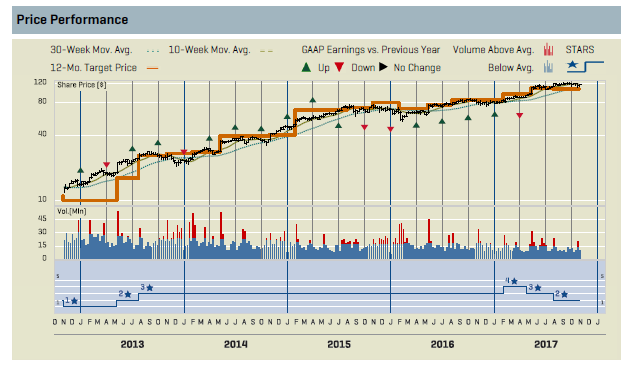
Some of the main highlights we could deduce from the above graph is the slight change in the company’s deferred revenues, which increased from 5% to 9%. This increase follows another change in the same index, which happened in FY15 to FY17, where there was an increase in deferred revenue from 6% to 8% (CFRA, 2017). These statistics indicate an ongoing progress in the company, characterized by the company’s increased attention to digital growth through investments in digital platforms (mostly touching on smartphone growth). A general analysis of the industry also shows a decline in sales associated with traditional software sold to retail stores and suchlike entities.
In the future, I estimate that there will be a general increase in non-GAAP earnings, especially in terms of gross margin. A 6% increase in this number could likely be reported in the year 2020. If this happens, EA would have a much favorable revenue mix for its shareholders. Again, I estimate that this positive outcome would mostly be attributed to a focus on digital growth numbers. Going forward, I also expect an increase in non-GAAP EBTIDA owing to a continued trend within the organization to trim its employee numbers to increase efficiency.
The company’s focus on reducing its number of game titles will also most likely contribute to the same outcome. Already, an independent analysis by Market on Demand (2017) in these two operational areas show that EA has successfully managed to scale its platforms and offerings using the same approach.
A general assessment of EA’s performance also prompts me to predict that the company could report a non-GAAP operating earnings per share (EPS) of 4.24 for the year 2018. This figure could slightly increase to 5.02 in 2019 based on patterns deduced from (Yahoo Finance, 2017). Compared with 2015 and 2016 figures of $2.51 and $3.14 respectively, I find that there is an emerging pattern of increased value in EPS that is backed by statistics from the last four years. The table below shows a comprehensive analysis of earnings data and the revenue per share for the company.
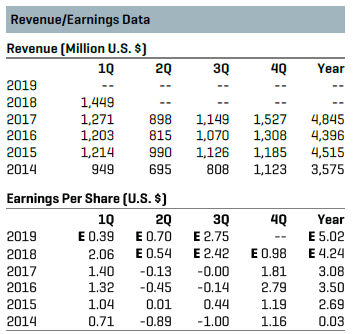
Undervalued Shares
A general evaluation of different quantitative measures associated with EA reveals that the company’s shares are mostly undervalued. Based on CFRA’s (2017) quantitative model, the company’s shares are ranked 4/5 with the most overvalued share being 1/5 and the most undervalued share being 5/5. A comprehensive analysis of the same index shows that the company’s shares are generally undervalued by about $2.36.
With a current fair value estimation of $118, I could assume that the company’s shares are undervalued by about 2%. Part of the company’s quantitative valuation also reveals that it is subject to low volatility in the industry, while the technical indicators have no general influence on the company’s performance (they have a neutral effect). An expanded ratio analysis for the company appears below.
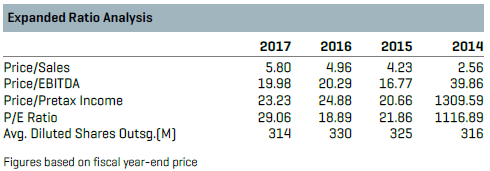
An analysis of the company’s key growth rates and averages also appear below
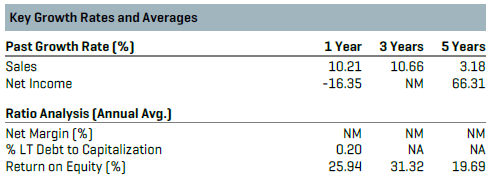
Investments and Risk Analysis
EA’s biggest risk profile is a decline in the sales of video game consoles. However, as witnessed through an analysis of the company’s latest strategy analysis, we find that it is moving from this market segment to the digital platform (through digital offerings). The benefits of this strategic direction were witnessed in 2015 when the company’s digital revenues surpassed those of traditional packaged software (Yahoo Finance, 2017).
This approach is part of a wider corporate vision for the company to become leaner, efficient and more focused on lucrative sectors of the market (CFRA, 2017). At the same time, the strategy informs the recent move by the organization to develop fewer games. Additionally, part of the company’s strategy has included partnering with other organizations, such as Disney World, FIFA Soccer and Madden NFL to improve the organization’s product offerings (CFRA, 2017).
Some of the risks I identify with this approach include an increase in performance beyond the predicted outcome mentioned above. This is largely due to the potential for a great reception of some of the games that the company is currently working on. Part of the risk also involves a stronger than expected adoption of the company’s mobile and social games, including a strong consumer spending appetite that could be buoyed by a stronger performance of the global economy.
Generally, I expect EA’s share price to hit $102 according to a 12-month industry assessment. A broader assessment of this index, viz-a-viz the performance of other companies in the industry reveals that other players reported an average forward price to earnings (P/E) ratio of 28.1X and a P/E-to-growth (PEG) ratio of 1.4X. If we use the same ratios by applying them to EA and comparing them to the aforementioned targets we could deduce that the company’s performance would be strong. Generally, my risk assessment takes into account different factors that could influence EA’s performance, including general economic performance, changes in consumer spending habits and the unpredictable nature of the home entertainment business.
The Sector
Valuation
An evaluation of EA’s P/E ratio portrays a positive picture for the company because its performance has been significantly discounted compared to an average of 45.58, which is associated with the software industry (The Street Ratings, 2017). The company’s P/E ratio is also at a premium, relative to the S&P average of 24.76 (The Street Ratings, 2017). An analysis of the company’s price-to-book ratio also presents the same story because the Street Ratings (2017) say it as 8.18, which outlines a significant premium considering the S&P average is 3.15. Independent reports also support the same narrative because the price-to-sales ratio is above the S&P 500 average (Yahoo Finance, 2017). However, it is also important to point that this index is below the industry average.
Based on the aforementioned measures of analysis, I find that EA trades at a discount, relative to other investment alternatives in the market. The table below presents a more comprehensive analysis of the company’s financial performance relative to its peers, using a few common financial indices, including P/E ratio, Price/Cashflow ratio, Price/Projected Earnings, Price to Earnings/Growth, Price/Book, earnings/growth ratio, price/sales ratio, and sales growth ratio.
Table 1: EA’s performance vs. Peer Perfromance.
Based on an analysis of the first five items on the table above, we find that EA is trading at a discount to its peers. However, in terms of earnings growth, the company is trailing its peers, while on price/sales ratio, it is at par with the industry. The same is true for its sales growth numbers.
Generally, a review of the industry performance shows that it has a neutral effect on EA’s performance. This fact comes from the understanding that there has been a general single digit growth for most of the industry players in the past three or four years. A snapshot of the industry’s performance also reveals that the sale of video games has always surpassed those of consoles (CFRA, 2017). The margins emerging from the sale of digital and mobile offerings seem to be spurring most of the growth witnessed in the industry today. According to Market on Demand (2017), the growth in this market segment seems to account for most of the revenues for the top three companies in this segment – EA, Activission Blizzard and Take-Two interactive.
A review of sales patterns in the industry also indicates a radical shift in the preference for mobile games, as opposed to console games. However, evidently, many large corporations in the sector realized this trend early and capitalized on it. Nonetheless, since mobile games have low hardware and software requirements to develop, I believe there are low barriers to entry in the sector. This industry feature may contribute to pricing pressures both in the long-run and short-run. A possible point of differentiation for existing companies would be brand name associations and creativity/innovation.
Although innovation may be the new arena of competition in the industry, it is also important to point out that the high product development costs associated with new software significantly affect the bottom line for most companies. A thorough financial analysis shows that the home entertainment and gaming industries are outperforming major financial indices in the market. For example, CFRA (2017) shows that the home entertainment software index increased by up to 47.2%, while the S&P reported gains of 7.2%. In 2016, financial analysts reported that the industry performed better than S&P 1500 because it reported a 5.5% measure while the index gained 10.6% (CFRA, 2017). A five-year market performance of the index vis-à-vis key performance indices appear below.

An independent report by CFRA (2017) also shows that the company’s share price has often outperformed S&P 500 in 2017 as shown below
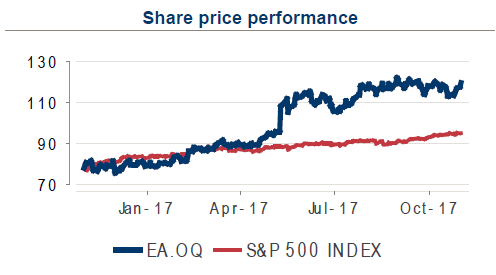
A deeper investigation of EA’s stock price over the past one year shows that the stock price has increased by up to 41.3% (Ford Equity Research, 2017). A review of the company’s historical stock price performance reveals that the next six (or so) months could accommodate a further increase in the company’s stock price. The historical performance is a reliable measure for making such an assumption because according to the Ford Equity Research (2017), it could help to identify the company’s intermediate and long-term earning potential. However, these two measures of competitive performance are often assessed, relative to how the company would outperform its competitors. A broader analysis of EA’s performance, vis-à-vis its competitors appears below.

The Economy
Although the US economy is slowly recovering from the aftershocks of the 2007/2008 global economic meltdown, there are still many uncertainties surrounding consumer spending habits. Although such unpredictabilities have worsened the demand for game console shipments, there is a growing traction for next-generation hardware, which has been observed among some industry experts, such as IDC (CFRA, 2017). Based on these dynamics, I should expect a mixed performance in the sale of video games in 2017 and 2018 from EA. This performance will be subject to new franchise releases.
In an unrelated sphere of analysis, a broad analysis of EA’s investments shows that the console game downloads is showing potential for growth in the international market. This outcome is partly evidenced from the mix of FIFA 18 which was better digitally received (25%) in 2017 compared to the previous year, where only 16% of customers used it (digitally) (CFRA, 2017). The reception of Madden Ultimate (a new game) also replicated the same pattern (CFRA, 2017).
In 2018, it is estimated that EA will have several channels for revenue growth (Ford Equity Research, 2017). These multiple channels are predicted to come from increased sales in several star wars transactions, unit volume gains, and the release of a mobile update for different franchises under the Sims franchise (Credit Suisse, 2017). Based on these factors, it is predicted that the company’s output will outperform most of those in the industry, buoyed by several key factors, which include a shift to digital market platforms, the adoption of microtransactions by a growing body of consumers, which is driving up incremental sales, and the increase of the company’s consumers to include global audiences (Ford Equity Research, 2017).
Conclusion
Based on the facts outlined in this study, I could deduce that EA is a buy stock because of the following reasons
- Strong earning potential.
- Stock is mostly undervalued.
- Immense potential in the digital market segment.
The listed factors could significantly increase its potential to outperform the market in the next 6-12 months. This view is grounded on the company’s financial performance, which has fared relatively well compared to the S&P 1500 and S&P 500 indexes. At the same time, EA is riding a wave of digital market growth, which has emerged after the decline of traditional gaming market consoles. It is important to emphasize this point because several analytical reports mentioned in this study highlight this fact.
They particularly draw our attention to the immense growth witnessed in the mobile gaming market because more people are willing to buy games to play on their mobile phones. The main challenge associated with this new market is the low barriers to entry which has been highlighted by selected reports highlighted in this paper.
The recommendation to buy EA stock is also partly supported by the company’s earnings potential, which has been highlighted in several reports highlighted in this study. For example, I found that in the past five quarters, it has reported a steady and commendable earnings per share for its shareholders. Additionally, the company reported significant price movements that are set to improve its future performance as well.
The undervaluation of the company’s stock also adds to my argument that the company’s stock is a “buy” because, relative to other organizations, the shareholders have not fully exploited existing market opportunities, especially in the global online gaming sector.
References
CFRA. (2017). Electronics Art Inc. Web.
Credit Suisse. (2017). Electronics Art Inc. Web.
Ford Equity Research. (2017). Electronics Art Inc. Web.
Market on Demand. (2017). Electronics Art Inc. Web.
The Street Ratings. (2017). Electronics Art Inc. Web.
Yahoo Finance. (2017). Electronics Art Inc. Web.